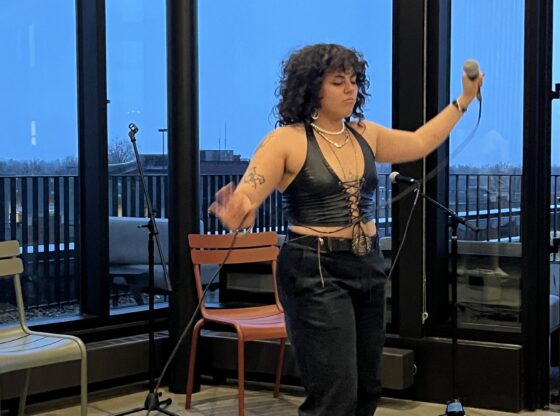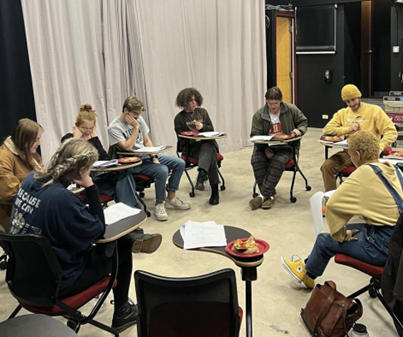 Photo by: Ryan Lumpkin
Photo by: Ryan Lumpkin
“They are very …. Wow!” were the responses uttered from viewers at the unveiling of the new anthropology exhibit, Borderlines, last Thursday evening at the University of Denver Museum of Anthropology Gallery (DUMA) in Sturm Hall.
Borderlines is a pertinent title for the exhibit because all of the photographs were taken from either side of the U.S.-Mexican border.
Erin McCarley, the curator of the exhibit, was a sociologist and a young photographer herself. After talking to McCarley she said she chose these types of photos in her exposition because it was an important part of the issue she wanted to express.
“We hear about anti-immigration rants in the U.S., but I wanted people to know the emigrant side [of the issue,] and what they experience leaving the political and economic forces of their home and trying to get into the U.S.,” said McCarley.
She is able to relate to this experience firsthand because she lived and worked on the U.S.-Mexican border for a time in her life. The events she experience were similar to the ones captured in the photos.
In her time on the border, she witnessed a man die from electrocution at a Tijuana factory. It was a shock to McCarley, but when she checked the news to see if it was reported, they said “that kind of stuff happens every day,” and it would not be reported.
The exhibit started at the Colorado Photographic Arts Center and moved to the anthropology museum at DU.
McCarley is either friends or mutual friends with all three artists. The three photographers contributing to the exhibit are Dana Romaoff, Mike Kane and Shaul Schwartz. Each artist chose to approach the common theme from a unique perspective.
Romaoff displayed her culturally deep pictures behind white matte and black frames which had a very simple but elegant look. The bright colors of the photos were accentuated by the plain framing style.
Her selection was called No Man’s Land: The Women of Mexico. This collection focused on the everyday life of women in Mexico. Interestingly, her photos had captions that could be read in both English and Spanish.
Kane’s photos were taken in simple black and white. His collection, titled Desert Vigilantes, consisted mainly of photos of self- proclaimed soldiers attempting to stop illegal immigration and the struggles of Mexican individuals attempting to cross the border.
One photo showed a man with a gun scanning the border for illegal immigrants, another depicted a stack of bullet casings in the foreground with a soldier in the back. One striking image was of a man hiding in a bush, terror on his face illuminated by the camera’s flash in the dark night.
“I walked in, saw all the collections and I was completely blown away,” said DU freshman Jake Newell.
Newell is a photographer himself and admires Kane’s work.
Schwartz also had an amazing collection. His photos were larger and in vibrant colors printed on canvas. His collection showed many violent and brutal images from different cities in Mexico.
It also depicted a few images of Hispanic culture in the U.S., contrasting the true danger of gangs and drugs in Mexico with the “cool” gangster and drug scene in which many Hispanic teens in the U.S. participate.
Schwartz’s pictures were not censored. One of his images included a police officer’s funeral with an open casket, murdered by drug lords. The unique part about this collection was the lack of titles. Each photo had a number which corresponded with caption written on a pamphlet at the exhibit.
Some of Schwartz’s photos appeared in The New York Times and Time Magazine. Seeing the images in person made the experience far more powerful for people who had seen them on The New York Times photoblog.
At the reception guests enjoyed drinks, pork and vegetarian tamales, and chips and salsa. Budding photographers were able to share their ambitions with established professionals. guests seemed equally impressed with the astounding photos.
It’s certainly believable that after witnessing this exhibit, people will certainly understand Erin McCarley’s message now. They have somewhat experienced it themselves through the photographs.
The Borderlines exhibition will be running through March 16 in room 102 of Sturm Hall. A film showing of”Wetback. The UnDocumented Documentary” will be shown on Feb. 22 as part of the exhibition.










